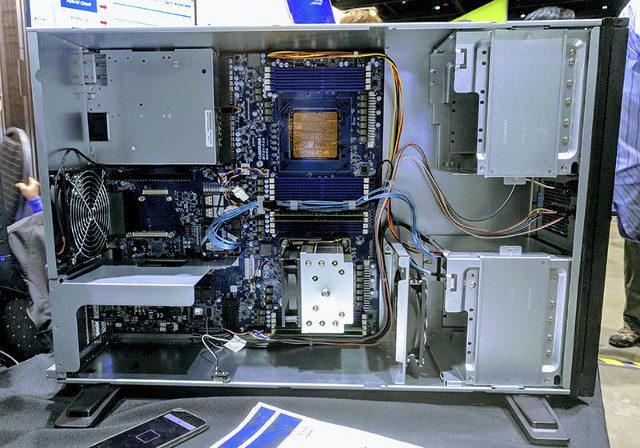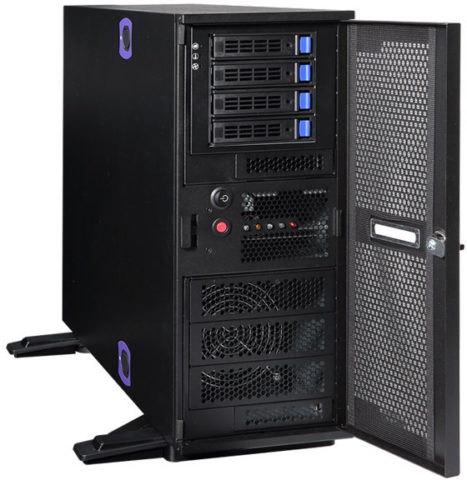Earlier this week, I wrote about the availability of Linaro “Synquacer” Developerbox that had been designed by GIGABYTE, but not using their brand, and I was pointed out to a possible reason: the company launched their own ARMv8 workstation based on Cavium ThunderX2 processor. Meet GIGABYTE ThunderXStation.
Main specifications:
- SoC – Single or Dual socket ThunderX2 32x custom ARM64 cores / 128 threads processor clocked at 2.2 GHz (other models of the processor may become available depending on demand)
- System Memory – Up to 16 DDR4 Channels (8x DIMM per CPU)
- Storage
- 4 x NVMe + 2 x 2.5” U.2/SATA III combo bay
- 2.5″ drive bay supports up to 2 drives, an optional 3.5″ storage bay holds 4 drives.
- Graphics – Nvidia GeForce GT710 with dual monitor support
- Networking – 2x 1/10 GbE QLogic NIC
- Expansion – 6x PCIe 3.0 Slots and 2x OCP (Open Compute Project) x16 slots
- BMC – ASPEED AST2500 with IPMI management SW
- Power Supply – 800W Platinum PSU with 1+1 redundant option
- Form Factor – 4U Tower
The workstation relies on AMI Aptio V UEFI and AMI MegaRAC BMC firmware, and runs Ubuntu 17.10, CentOS 7.4, or OpenSUSRE according to the FAQ. It also ships with gcc/LLVM/gdb toolchain, OpenJDK 9.0, and supports KVM & Docker.

The platform is a much more powerful beast than the Synquacer developer platform with up to 64 high performance cores, support for plenty of memory with up to 16 RAM slots, dual 1/10GbE interfaces, and a good amount of PCIe/OCP slots. It is designed for Arm software development for Android, gaming, embedded and NFV applications.
Pricing information is not public, but the system will likely cost several thousands dollars. The ThunderXStation (SKU: W281-T90) is however available, and you can contact server.grp@gigabyte.com or Phoenix Electronics to place an order.
[Update: Some pricing info is available via Avantek: £9,540.00 to £11,745.00 (~$13,500 to $16,700) for a dual processor system with respectively 32GB RAM/960GB NVMe/4TB HDD, or 128GB RAM, 960GB NVMe. They call it ThunderX2Station instead of ThunderXStation]
Thanks to kcg for the tip.

Jean-Luc started CNX Software in 2010 as a part-time endeavor, before quitting his job as a software engineering manager, and starting to write daily news, and reviews full time later in 2011.
Support CNX Software! Donate via cryptocurrencies, become a Patron on Patreon, or purchase goods on Amazon or Aliexpress






When looking at the FAQ, Ubuntu seems to be the default OS (not Centos). Centos and OpenSUSE are additional options: “Units ship with Ubuntu 17.10. CentOS 7.4 and OpenSUSE are also available. “
The press release only mentions CentOS, but you’re right the FAQ stays it ships with Ubuntu 17.10 (a strange choice since it will not supported after one month). The FAQ is more recent than the PR, so it must be correct though.
@Laurent Simon
In theory with those 64-bit ARM thingies compliant to Server Base System Architecture (SBSA) specification it shouldn’t matter any more which distro image you use any more unlike situation with ARM in the past where you always need a fine-tuned OS image for exactly the hardware you want to use.
But I doubt this will work that great yet due to both kernel support (missing) for recent hardware and some distro ‘anomalies’ that can ruin performance. Ubuntu’s initscripts package for example contains an /etc/init.d/ondemand script that gets called at boot, then sits in the background for 60 seconds and then chooses one random cpufreq governor based on what’s available by the kernel. If it chooses the wrong one your workstation performance drops a lot.
At least in the past with OS images that used different kernels for each platform that resulted always in unpredictable results since both what the vendor wants (kernel defaults) and what the user wants (cpufrequtils settings) gets ignored by this script that chooses $something based on some hardcoded ‘logic’.
The problem is that the initscripts package with its ondemand script only takes care about the situation on x64/amd64 systems with Ubuntu’s own kernels for this platform in mind. When running in a different environment (e.g. arm64 here) this might result in trashed performance due to different behaviour of different cpufreq governors on different platforms (e.g. ‘powersave’ is an excellent choice on recent Intel and AMD systems while destroying performance on ARM).
What if the actual use for this system except for server ?
For desktop use there are no good apps.
@Charlie, what’s ‘desktop use’? I use the same (or equal functionality) software across all my linux, macos and win desktops — be they amd64 or arm64. I’m referring to browsers, toolchains and editors.
@Charlie
4U towers are servers.
@Charlie this is intended as a server, or a dev version of a server (a dev might keep it at their desk instead of in a rack), but that said, I could 100% use this as a desktop
pitty it can only do 16GB of ram, would otherwise be nice to run load of virtual machines on
jeroen: It’s 16x DIMMS – 8 per CPU socket. Not 16GB. The FAQ doesn’t actually say what the size limit is but presumably it’s plenty.
Wonder how it compares to the Talos II, if that ever gets out of pre-order.
@notzed
Considering the closed firmware and low clock rates, I’d say it compares poorly for non-server workloads.
I suspect some need to think of this as refined hardware for refined use, rather than as a general purpose machine. Also, it is early days with sales to the target customers. So expect tweaking and fixing of the undocumented features.
Added some pricing information from Avantek in the post.
A dual processor system with 32GB RAM, 960GB NVMe SSD, 4TB HDD sells for around $13,500.
Rather expected. No prices for the single-socket configs yet?